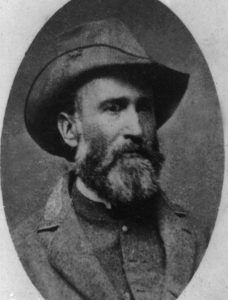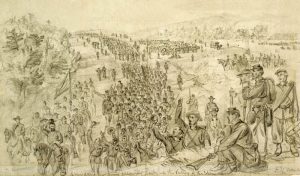In 1864, Confederate General Robert E. Lee was concerned about Major General David Hunter’s advances in the Shenandoah Valley, which threatened critical railroad lines and provisions for the Virginia-based Confederate forces. He sent Lieutenant General Jubal Early’s corps to sweep the Union forces from the Valley and, if possible, to menace Washington, D.C., hoping to compel Lieutenant General Ulysses S. Grant to dilute his forces against Lee around Petersburg, Virginia.
Early was off to a good start operating in the same area that Thomas J. “Stonewall” Jackson had in his successful 1862 Valley campaign. Entering the Valley without opposition, he bypassed Harpers Ferry, crossed the Potomac River, and advanced into Maryland. In response, Union General Grant dispatched a corps under Horatio G. Wright and other troops under George Crook to reinforce Washington and pursue Early.
Cool Spring (July 17-18, 1864) – Also known as the Battle of Island Ford, Parkers Ford, Snickers Ferry, and Castleman’s Ferry, this two-day engagement occurred in Clarke County. A Union column, consisting of the VI Corps and elements of the XIX Corps under Major General Horatio Wright, pursued Lieutenant General Jubal Early’s army as it withdrew from the environs of Washington, D.C. Wright’s force was joined by elements of Brigadier General George Crook’s command, which had accompanied Hunter during his retreat through West Virginia. On July 17, the Union cavalry passed through Snickers Gap and attempted to force the Shenandoah River passage at Snickers Ford (Castleman’s Ferry). On the morning of July 18, the vanguard of the Union infantry moved through Snickers Gap. Colonel Joseph Thoburn (of Crook’s command) led his division downstream to cross the river at Judge Richard Parker’s Ford. Confederate General Early’s three nearby infantry divisions moved to defend the fords. Major General Robert Rodes’s division attacked and shattered Colonel Thoburn’s right flank on the Cool Spring plantation in the afternoon. Thoburn made a stand behind a stone wall at the river’s edge and beat off three attacks until darkness enabled him to withdraw. The Union pursuit of Early was delayed several days. The Confederate victory resulted in estimated casualties of 422 Union and 397 Confederate.
Rutherford’s Farm (July 20, 1864) – Also known as the Battle of Carter’s Farm and Stephenson’s Depot, this battle occurred in Frederick County and Winchester, Virginia. Union Brigadier General W.W. Averell’s division attacked Major General S.D. Ramseur’s Confederate division at Rutherford’s and Carter’s farms. This sudden assault came in on General Robert Hoke’s brigade’s flank as it deployed, throwing it into a panic. Ramseur retreated toward Winchester in confusion. Union General Averell captured four pieces of artillery and nearly 300 men. Early withdrew his army south to a defensive position at Fisher’s Hill with this defeat. The Union victory resulted in estimated Union casualties of 220 and 45 Confederate.
Kernstown II (July 24, 1864) – This engagement occurred in Frederick County and Winchester, Virginia. Believing that Confederate General Jubal Early was no longer a threat in the Valley, Major General Horatio Wright abandoned his pursuit. He ordered the VI and XIX Corps to return to Washington, where they were to be sent to Lieutenant General Ulysses S. Grant’s “army” group” before Petersburg. Wright left Brigadier General George Crook with three divisions and some cavalry to hold Winchester. Under orders to prevent reinforcements from being sent to Grant, Confederate General Jubal Early marched north on July 24 against General Crook. After an hour of stubborn resistance at Pritchard’s, the Federal line collapsed, and Crook streamed back in disarray through the streets of Winchester. Colonel James Mulligan, commanding Crook’s Division, was mortally wounded. Rutherford B. Hayes commanded a brigade against Confederate General John C. Breckinridge. Crook retreated to the Potomac River and crossed near Williamsport on July 26. As a result of this defeat and the burning of Chambersburg, Pennsylvania, on July 30, Grant returned the VI and XIX Corps and appointed General Philip Sheridan as commander of Union forces in the Valley. The Confederate victory resulted in estimated casualties of 1,200 Union and 600 Confederate.
Compiled and edited by Kathy Alexander/Legends of America, updated February 2024.
Also See:
Sources:
Battlefields.org
National Park Service Battle Descriptions (no longer available online)
National Park Service Civil War
Wikipedia



